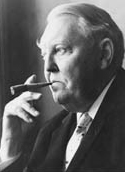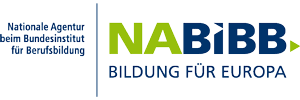Welcome to the homepage of the Ludwig-Erhard-Berufskolleg (LEB).
leb.bonn@schulen-bonn.de
I. Description of the educational opportunities at the LEB
II. Organizational Structure and Personnel at the LEB
III. Conclusion and future prospects
Who was Ludwig Erhard?

From 1949 to 1963 Ludwig Erhard was Secretary of State for Trade and Industry in the cabinet of Konrad Adenauer and from 1963 to 1966 Chancellor of the Federal Republic of Germany. This era was characterised by high growth rates of the General National Product (GNP) and full employment.
The name Ludwig Erhard stands for the German “Wirtschaftswunder” and the social market economy. This economic system primarily abstains from state intervention and lets the market forces work, but also considers the social conditions so that the entire population can participate / for the entire population to participate in the economic progress.
I. Description of the educational opportunities at the LEB
The LEB is a College of Further Education, a vocational school in the occupational fields of Industry, Commerce and Administration. We distinguish between two parts
- the part-time vocational school 2.300 students
- the full-time vocational school 500 students
1. Part-Time vocational school
The part-time vocational training is our main part. The characteristic feature of the vocational education is the dual system of vocational training:
At the age of 17, 18, 19 or 20 the young adult signs a vocational training contract with a company after having completed a school offering general education. This training contract automatically results in the trainee’s duty to attend a part-time vocational school two days a week. The company provides the practical part of the training, the school the theoretical part. At our college we do have students who are trained in 7 different recognized occupations (see below).
Generally, a trainee is 2 days in school and 3 days in the company. However, there are different forms to organize schooling.
Normally, the training covers a period of 3 years and ends with passing the final exam. After the exam, the company can offer its trainee a permanent job, however, does not have to do this. Students showing a good performance during the training can reduce the duration of the education.
| Part-time vocational school: dual system of vocational training Training takes place…Þ in the company Þ in school | |||
| recognized occupation | length of training | organisational structure | |
1 | Bank Business Management Assistant | 2.5 years | 6 weeks – twice a year |
2 | Insurance Business Management Assistant | 3.0 years | 2 days per week |
3 | Management Assistant for Tax Consultants | 3,0 years | 2 days per week |
4 | Management Assistant for Real Estate Agents | 3,0 years | 2 days per week |
5 | Assistant in Public Administration | 3.0 years | 6 weeks – twice a year |
6 | Management Assistant in Office Management | 3,0 years | 6 weeks – twice a year |
7 | Management Assistant for Doctors | 3,0 years | 2 days per week |
8 | Management Assistant for Dentists | 3,0 years | 2 days per week |
2. Full-time vocational school
Students attending this form of vocational school do not have a vocational training contract. Their training takes place completely in school and they attend school 5 days a week. Depending on their qualifications various options are offered, ranging from 1 to 3 years.
Full-time vocational school | ||||
| Course | duration | required qualification | school-leaving level | |
| 1 | full-time (basic) vocational school | 1.0 years | certificate of completion of compulsory basic secondary schooling | intermediate school-leaving certificate |
| 2 | full-time (higher) vocational school | 2.0 years | intermediate school-leaving certificate | part of the certificate of aptitude for specialized short-course higher education |
| 3 | specialized upper secondary school | 1.0 year | intermediate school-leaving certificate + vocational training | Full certificate of aptitude for specialized short-course higher education |
| 4 | specialized academic secondary school | 3.0 years | intermediate school-leaving certificate | general certificate of aptitude for higher education |
| 5 | Commercial assistants for foreign languages | 2.0 years | general certificate of aptitude for higher education | exam in the recognized occupation: commercial assistant for foreign languages |
- The 1-year course of the full-time basic vocational school, type A, is intended for students leaving the lower secondary school. When passing the course, they will achieve the certificate of aptitude for specialised upper secondary studies.
- The 2-year course in the full-time higher vocational school is intended for students with good grades in the certificate of aptitude for specialised upper secondary studies. When passing the final exam after 2 years the students achieve the theoretical part of the certificate of aptitude for specialized short-course higher education. In connection with an internship or a vocational training in a recognized occupation the students receive the full certificate of aptitude for specialized short-course higher education and are entitled to start this higher education at a college, the so-called “Fachhochschule”.
- The 1-year course at the specialised upper secondary school also provides the certificate of aptitude for specialized short-course higher education. However, the students attending this course, already dispose of the intermediate school-leaving certificate plus a vocational training.
- Students with really good grades in their intermediate school-leaving certificate can go for the general certificate of aptitude for higher education, called “Wirtschaftsabitur”, as the focus is on business studies. With this certificate the students can start their studies at a university.
- Last but not least our college offers a 2-year course “Commercial Assistant for foreign languages”, intended for students disposing of the general certificate of aptitude for higher education plus good knowledge in English and French. This course is a training in a recognized occupation but takes place completely in our college / school.
II. Organizational Structure and Personnel at the LEB
1. Organizational Structure
The college is run by the school administration, consisting of 2 members.
The heads of department participate strongly in deciding on the teachers who work in their department. Furthermore, they co-ordinate the courses of studies and are responsible for further details. There are conferences for the different subjects within the departments in which special requirements of the subjects are discussed and the papers for the final exams are prepared.
2. Rights to participate
There are different decision-making bodies involved when essential school matters have to be decided. The principal discusses essential new developments with the heads of department and the “Lehrerrat”, which is the teachers’ representing body, before all teachers are informed in the teachers’ conference.
The main decision-making body is the “school conference” comprising teachers, students, parents of underage students, employers and employees. This conference decides, for example, on educational principles, remarks in the report about the student’s working and social behaviour as well as the school budget.
3. Personnel / Staff
This college has about 120 teachers. More than 50 % of the staff are women.
Each school is allowed to recruit the personnel on its own following a standardized procedure. There is a special “recruiting committee” consisting of the principal, a teachers’ representative, an equal rights representative and a member of the staff council.
III. Conclusion and future prospects
The present and future tasks in a College of Further Education are complex and increasing constantly.
- A main task of the vocational schools will be to provide young adults who have educational deficits with the best training possible so that they can find a job.





